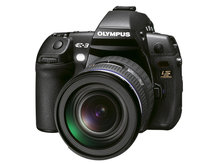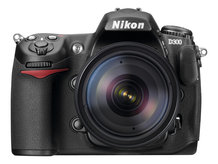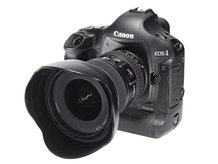Editor's Choice: Top 10 digital SLR cameras
The best DSLR snappers all in one place
Olympus E-3 - £1000

From the moment you pick up the E-3, you feel like you're holding a thoroughly well-built piece of kit.
The camera looks superb and despite being a fairly bulky camera it feels good in the hand.
The build quality is excellent and everything from the switchgear, to the seals that keep out dust and water, are just right.
Our first experience with the E-3 was during a torrential downpour at the camera's launch.
Thankfully, not one of the 40 review models being tested broke down.
That, in itself, is proof enough that Olympus has made a camera that can properly withstand the stresses and strains of a professional use.
Sign up for breaking news, reviews, opinion, top tech deals, and more.
This is a photojournalist's camera: tough yet light enough to perform in harsh conditions for both camera and photographer.
At the heart of the E-3 is a new Four-Thirds Panasonic 10MP NMOS image sensor. A Four-Thirds sensor is quite a bit smaller than the APS-C sensors found in most other D-SLRs and yet the E-3's high ISO performance looks very good indeed.
When used with the sublime Zuiko 12-60mm f/2.8-4 SWC zoom lens, the Olympus E-3 makes for a compelling photographic tool that we simply couldn't help falling in love with. Read our full review
Nikon D300 - £1000

The most notable new feature in the Nikon D300 is the new 12.3-megapixel CMOS sensor.
It's remarkably 'similar' to the Exmor model used in the new Sony Alpha A700.
Of course, adding two million extra pixels isn't going to make much difference to the image quality, but this isn't just a reheated version of the old sensor.
Nikon's swapped from CCD to CMOS technology with a brand-new and advanced sensor design that delivers more than just a few extra pixels.
There's the increased ISO range, for a start.
This runs from ISO 200-3200, with 'extended' settings of ISO 100 and ISO 6400 for extreme lighting conditions.
But the full-frame D3 (reviewed below) at around £3,000 has well and truly pulled the rug from under the D300.
How can you justify spending thousands on DX SLRs and DX lenses when they've become a second-division choice compared with Nikon's FX sensor format?
And for those who don't face this kind of dilemma, who are simply looking to invest in a top-quality APS-C D-SLR.
The Sony Alpha 700 virtually matches the D300's specs and it's much cheaper. Read our full review
Canon EOS 1D Mark III - £2400

The Canon EOS 1D is a camera that's been designed with today's photographer in mind.
From a smaller, weight-shaving battery to a three-inch LCD, complete with Live View, even the neck strap's undergone a redesign.
Canon has reduced the number of buttons too, and switched operation from a two-button and dial combination to a single button press and dial shift to change key functions.
It makes much more sense.
To be frank, this camera sits out there on its own in the DSLR market, especially in this price bracket. Only the Nikon D3 (reviewed below) can rival it.
The image quality it's capable of is simply stunning. Margarine-smooth images at ISO 100 and 200, low-noise shots at ISO 400 - and eye-openingly good above that.
ISO 1600 is of such an acceptable quality that it opens up new photographic opportunities, delivering action-stopping shutter speeds at low light levels.
The files are of such a beautiful quality to begin with that they hold up well to processing too.
You'll need to shoot RAW to take advantage of the full potential of this camera, but the results are worth it.
This is a brilliant camera - whether you're willing to pay £2400 for it is another story. Read our full review
Nikon D3 - £2800

Don't be confused by the price with this one. With many DSLR's, the cheapest price listed is merely the camera body without any extras (lenses etc).
The brilliant Nikon D3 is slightly more pricey than the Canon 1D.
But it comes with the brand-new Nikkor 24-70mm f/2.8 N-series lenses and Nikon's fabulous 14-24mm N-series wide-angle zoom.
The D3 is a full-frame SLR, so that 14mm zoom is so wide you'll be lucky to keep your ears out of the picture.
The 1Ds Mk III has 21 million pixels. The D3 has 12 million pixels, which is not as many but still a lot.
Some clients may demand 21-megapixel files, but how many? You have to weigh this against the D3's better value and certain other capabilities that the Canon doesn't have.
These include the fact that the 1Ds Mk III can shoot at 5fps, while the D3 shoots at 9fps.
The 1Ds Mk III goes from ISO 100-1600, but the D3 goes from ISO 200-6400 (yes, 6400).
Compared with its rivals, the D300 is exceptional at ISO 1600. The D3, though, just blows it away.
In fact, at ISO 6400, the D3 is producing similar image quality to the D300 at ISO 1600. Truly remarkable.
Indeed, the D3 gives you more of everything that's so admirable in the D300.
More colour, less noise, faster frame rates. It's a spectacularly good camera.
So good, in fact, that we have to repeat our only caveat about the D300.
Good as the cheaper model is, we suspect you're always going to be wondering whether the D3 wouldn't have been the better professional buy. Read our full review

James was part of the TechRadar editorial team for eight years up until 2015 and now works in a senior position for TR's parent company Future. An experienced Content Director with a demonstrated history of working in the media production industry. Skilled in Search Engine Optimization (SEO), E-commerce Optimization, Journalism, Digital Marketing, and Social Media. James can do it all.